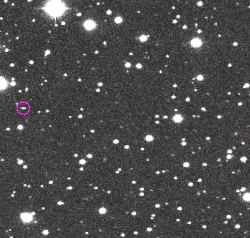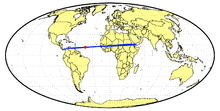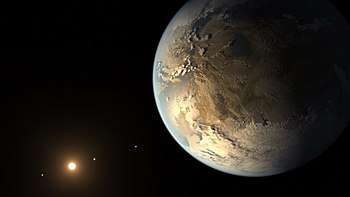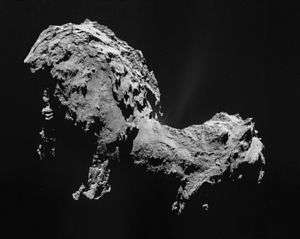2014 AA
2014 AA was a small Apollo near-Earth asteroid roughly 2–4 meters in diameter that struck Earth on 2 January 2014.[1] It was discovered on 1 January 2014 by Richard Kowalski at the Mount Lemmon Survey at an apparent magnitude of 19 using a 1.52-meter (60 in) reflecting telescope at Mount Lemmon Observatory.[1] 2014 AA was only observed over a short observation arc of about 70 minutes,[1] and entered Earth's atmosphere about 21 hours after discovery.[3] Nonetheless it remains one of only a few asteroids observed before impact (see Asteroid impact prediction).[4]
 2014 AA imaged by the Catalina Sky Survey in January 2014. The asteroid was around one lunar distance from Earth at that time. | |
| Discovery[1] | |
|---|---|
| Discovered by | Richard Kowalski Mount Lemmon Survey (G96) |
| Discovery date | 1 January 2014 |
| Designations | |
| 2014 AA | |
| Orbital characteristics[2] | |
| Epoch 1 January 2014 (JD 2456658.5) | |
| Uncertainty parameter 9 | |
| Observation arc | ~70 minutes[1] |
| Aphelion | 1.4080 AU (210.63 Gm) (Q) |
| Perihelion | 0.9163 AU (137.08 Gm) (q) |
| 1.1623 AU (173.88 Gm) (a) | |
| Eccentricity | 0.2116 (e) |
| 1.25 yr (457.26 d) | |
| 324.1460° (M) | |
| 0° 47m 14.244s / day (n) | |
| Inclination | 1.4156° (i) |
| 101.6086° (Ω) | |
| 52.3393° (ω) | |
| Earth MOID | 4.54412×10−7 AU (67.9791 km) |
| Jupiter MOID | 3.58092 AU (535.698 Gm) |
| Physical characteristics | |
| Dimensions | ~3 meters (10 ft) |
| Mass | ~4×104 kg (assumed) |
| 30.9[2] | |
Entry

Using a poorly determined orbit, the JPL Small-Body Database listed a 3-sigma solution with impact occurring around 2 January 2014 02:33 UT ± 1 hour and 5 minutes.[5] The Minor Planet Center listed impact as occurring around 2 January 2014 05:00 UT ± 10 hours.[1] Independent calculations by Bill Gray, the Minor Planet Center and Steve Chesley at the Jet Propulsion Laboratory verified that impact was virtually certain.[1]
The impactor would have been roughly the size of 2008 TC3, which exploded above the Nubian Desert in Sudan on 7 October 2008. Calculations by Chesley suggest the impactor fell somewhere on an arc extending from Central America to East Africa, with a best-fit location just off the coast of West Africa.[1] Calculations by Pasquale Tricarico using the nominal orbit show that 2014 AA entered Earth's shadow cone approximately 40 minutes before entering the atmosphere.[6]
Infrasound was detected by three stations of the Comprehensive Nuclear-Test-Ban Treaty Organization.[7] Peter Brown and Petrus Jenniskens located weak signals from infrasound stations in Bolivia, Brazil and Bermuda.[3] 2014 AA entered Earth's atmosphere around 03:06 ± 5 min UT,[8] 3,000 km from Caracas, Venezuela, far from any landmass.[7][8] No ships or planes reported witnessing the event.[7] A recalculation of the impact parameters of this meteor based on infrasound recordings gives a longitude of impact of nearly 44º West and a latitude of 11º North, the impact time being 2456659.618 JD UTC.[9] Extensive numerical simulations indicate that, prior to impact, 2014 AA was subjected to a number of secular resonances and it may have followed a path similar to those of the NEOs 2011 GJ3, 2011 JV10, 2012 DJ54, and 2013 NJ4; NEOs in this transient group experience close encounters with the Earth-Moon system at perihelion and Mars at aphelion and could be a dynamical family.[9]
Other discoveries
Kowalski previously discovered 2008 TC3, the first asteroid discovered before Earth impact, using the same telescope in October 2008.[7] There are about a billion near-Earth objects in the size range of 2014 AA, and impacts of comparably-sized objects occur several times each year.[3]
Several years later, 2018 LA was also discovered by the Mount Lemmon Survey, and ended up impacting Earth in southern Botswana in June 2018.
See also
References
- "MPEC 2014-A02 : 2014 AA". IAU Minor Planet Center. 2 January 2014. Retrieved 2 January 2014. (K14A00A)
- "JPL Small-Body Database Browser: (2014 AA)" (last observation: 1 January 2014; arc: 1 day). Jet Propulsion Laboratory. Retrieved 4 April 2016.
- "The First Discovered Asteroid of 2014 Collides With The Earth – An Update". NASA/JPL. 3 January 2014. Retrieved 4 January 2014.
- "Tiny Asteroid Discovered Saturday Disintegrates Hours Later Over Southern Africa". NASA/JPL. Jet Propulsion Laboratory. Retrieved 4 June 2018.
- "JPL Close-Approach Data: (2014 AA)" (last observation: 1 January 2014; arc: 1 day). Retrieved 2 January 2014.
- Guido, Ernesto (2 January 2014). "Small asteroid 2014 AA hit the Earth's atmosphere". Associazione Friulana di Astronomia e Meteorologia. Retrieved 2 January 2014.
- Beatty, Kelly (2 January 2014). "Small Asteroid 2014 AA Hits Earth". Sky & Telescope. Retrieved 3 January 2014.
- Farnocchia, Davide; Chesley, Steven R.; Brown, Peter G.; Chodas, Paul W. (1 August 2016). "The trajectory and atmospheric impact of asteroid 2014 AA". Icarus. 274: 327–333. Bibcode:2016Icar..274..327F. doi:10.1016/j.icarus.2016.02.056.
- de la Fuente Marcos, C.; de la Fuente Marcos, R.; Mialle, P. (13 October 2016). "Homing in for New Year: impact parameters and pre-impact orbital evolution of meteoroid 2014 AA". Astrophysics and Space Science. 361 (11): 358 (33 pp.). arXiv:1610.01055. Bibcode:2016Ap&SS.361..358D. doi:10.1007/s10509-016-2945-3.
External links
- The atmospheric impact trajectory of asteroid 2014 AA – arXiv 13 January 2016
- Two maps of the possible impact region (Yahoo groups / Project Pluto)
- 2014 AA – New Year’s Earth impactor (Carl W. Hergenrother)
- ScienceAtNASA – ScienceCasts: New Year's Asteroid Strike on YouTube (time 4:25 min.)
- 2014 AA at the JPL Small-Body Database


